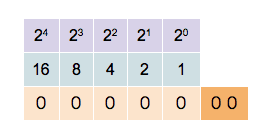Part 2 - The Story of Number One: From Roman Numerals to the Digital Age

The number one became the backbone of the Roman world as the Romans used it to impose a rigid numerical grid on their army. There were ten men in a section. One hundred men were called a century. Two centuries were called a manipulus. Even punishments were dealt out on numerical principles. If a legion suffered a humiliating defeat, one soldier in ten was killed regardless of individual guilt.
It is pretty apparent that numbers had a more practical use in the Roman world, and theoretical mathematics was not a priority as it once was. The Roman numerals were essentially refined versions of the simple tallies found on the Ishango bone or the stamps Sumerians used on clay tablets. The only sophistication was there being new symbols as the numbers progressed: such as V for five, X for ten and C for one hundred. Yet it was merely a simple counting system, one that was not suitable for the complexity of theoretical mathematics. It comes as no surprise that Roman numerals were not used for counting and calculating, instead, an early version of an abacus was used.
Over the next half a century, most of Europe came under Roman control. And as Roman power spread, so too did its numeral system.

However, a different numeral system was being used in the East. One that would crush the seemingly “indestructible” Roman numerals. Our attention now turns to India in 500 A.D. The Indians were less concerned about military organisation than their Roman counterparts. Instead, their focus was on renouncing the world and finding enlightenment. However, the road to enlightenment was a stupendously long one. So, to convey that fact, the Indians came up with some pretty big numbers. Rajju, for example, is the distance covered by God in six months if he travels a million kilometres in every blink of his eyelid. Or Palya, the length of time it would take one to build a cube of lambswool ten kilometres high if one were to lay one strand every century.
Unlike the Romans, the Indians created a system fit for large numbers and endless possibilities. They developed a different symbol for every number from one to nine. However, the biggest revolution in numbers was the invention of zero. It transformed the power of the number one in a way that would change the entire world.
On its own, the number zero has no value. However, if paired with the number one, infinitely large numbers could be made. As well as infinitely small. Because of this extraordinary invention, Indian astronomers were centuries ahead of the Christian world. Indian scientists discovered that the Earth spins on its axis and moves around the sun. They even calculated the diameter of the globe and were less than one per cent off what it actually is.
India’s numeral system was a sensation and its fame soon began to spread across the globe. It made its way across the deserts of Arabia to take on one of the most sophisticated societies of its age in what is now Iraq.
When Islam was a little more than one hundred years old, Baghdad was ruled by the caliph Al-Mansur. The caliph wished for his people to live according to the Quran so he set up courts and judges to apply the law of the prophet. The law of the prophet is a set of instructions that require serious mathematical calculations if they are to be carried out exactly. One such example is the matter of inheritance. Unlike Christianity, there was a share of property for both men and women, and the magnitude of that inheritance depended on the number of other relatives and their relation to the deceased. Working that out required fractions and ratios, yet the people of Baghdad still counted on their fingers.
One day, the court of Al-Mansur received a distinguished ambassador from India, tasked with presenting a gift to the great caliph. After careful consideration, the ambassador chose to bestow upon the caliph the gift of numbers. This new numerical system captivated the minds of Muslim scholars, among them the renowned Al-Khwarizmi. Collaborating with his colleagues, Al-Khwarizmi delved into the exploration of numbers, applying them to innovative mathematical concepts, including quadratic equations, algebra, and logarithms. These groundbreaking mathematical achievements propelled science, mathematics, and astronomy to unprecedented heights in the Middle East.

However, on the other side of the Mediterranean, Christian Europe was still in the static world of Roman numerals. A reality that would only remain temporary. The beginning of the end for this numerical system started in North Africa as Muslim traders were quick to adopt one and zero for their business ventures. By the end of the twelfth century, Indian numerals were in common use.
It was in the busy port of Bijaya that the young son of an Italian diplomat based in Algeria first witnessed the use of these numbers. That young man was known as Fibonacci, and he was so impressed by the Indian numerals that when he grew up, he decided to take them home to Italy. In 1202, Fibonacci wrote a book about calculations, which he ingeniously named: The Book of Calculations. He is now regarded as one of the greatest mathematicians of all time, and his book was a showcase of the Indian numbers. Part of the Book of Calculations was aimed specifically at merchants, showing them how useful Indian numerals could be for calculating profits and converting different currencies.
Centuries after Fibonacci had brought them to Europe, the Indian numbers had finally outmanoeuvred the Roman numerals as they proved to be more compatible and versatile. The full troupe of Indian numbers took over the Western world, and with them, European navigators found it easier to calculate their latitude and so managed to cross the great oceans. Despite the advantage that came with using Indian numbers, there was still great room for human error. Christopher Columbus, for example, thought he had reached Japan when he was in fact in the West Indies; it was a simple mistake and something one man, Godfrey Wilhelm Leibniz, was determined to stop.
Leibniz was one of the greatest mathematicians of all time and he had set out to rid mankind of the curse of human error. In trying to do this, he invented a mechanical calculating machine using all the numerals from zero to nine. After building the machine, he thought of a better idea, one built upon his philosophy: Leibniz was convinced that one and zero were the only numbers that anyone really needed. With these two numbers, he developed a system called the binary system.
Let us take the number 27 as an example. 27 in binary is 11011. In our system of writing numbers, we use place values. All two-digit numbers, such as the number twenty-seven, have a ten's place and one's place digit. You can think of each “column” of a number as being a different place value. However, in binary, the "columns" keep track of how many ones, twos, fours, eights, sixteens, thirty-twos and sixty-fours there are in a number.

If we look at the binary counter above, we can see that...
The number 2 has a 1 in the two’s column.
The number 3 has a 1 in the one’s and two’s columns because 1 + 2 = 3.
The number 4 has a 1 in the four’s column.
The number 5 has a 1 in the one’s and four’s columns because 1+4=5.
Using this logic, the number 27 would have a 1 in the one’s column, two’s column, eight’s column, and sixteen’s column:
1 + 2 + 8 +16 = 27. Therefore 27 in binary is 1101.
Arguably, the binary system is a very mechanical way of identifying numbers which is why it is perfect for machines. Whilst humans have a harder time keeping track of large numbers in binary, machines are very efficient at it. And Leibniz designed exactly such a binary machine using metal balls dropping into slots, unfortunately, it never came to fruition. One and zero would have to wait another 265 years before such a machine would actually be built: it was The Colossus computer, the world's first programmable digital electronic computer, which played a crucial role in breaking German encrypted messages during World War II. It was developed by British codebreakers at Bletchley Park, led by engineer Tommy Flowers.
The binary system was pivotal in the Colossus computer for several reasons. To start, Colossus used electronic valves (vacuum tubes) to perform its calculations. These valves could be in one of two states: on or off. The binary system, which uses 0s and 1s to represent information, was ideal for encoding and processing data in an electronic circuit. The binary system was used to represent the encrypted messages and the internal workings of the computer. By converting letters and numbers into binary code, Colossus could process and analyze the data efficiently.
The Colossus computer only scratched the surface, however, of what digital electronic computers could achieve. This binary code using the numbers one and zero is fundamental to all modern computing systems, from simple microcontrollers to powerful supercomputers. The principles and technologies developed during the era of the Colossus laid the foundation for the digital age which is characterised by the widespread use of digital computers for various applications.
We have many great inventions and mathematicians to thank for the modern digital age we now live in. And it all started with the number one. The story of the number one is truly remarkable. It started as a simple mark on a bone and turned into something that would eventually change the world as we knew it.



